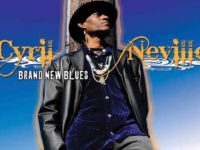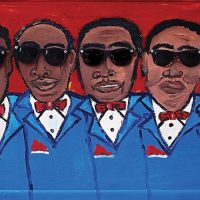It’s hard to define Aaron Neville’s music. Even for Aaron Neville.
Rhythm and blues? He nods. Soul? He nods. Gospel? Now more than ever. But country? He and his brothers do it all. In fact, Neville’s signature move is pure country: a falsetto, yodel-like tremolo.
Even with the success that collaborations with Linda Ronstadt brought in the 1990s, he never stopped performing and recording with the Neville Brothers. “That’s the franchise,” he told me, moments before going on stage.
For much of the 1970s and ’80s, Neville was better known for his work with those famous siblings, with whom he toured constantly. That, despite an explosive entry into the pop charts with the late-1960s hit “Tell It Like It Is.” But his work with early country-rock star Ronstadt seemed to embolden Neville’s solo work. Not only did he find himself on the pop charts again with hits like “Don’t Know Much” and “Everybody Plays the Fool,” he even came to embrace those country leanings.
In the early 1990s, he recorded “The Grand Tour,” written by George Jones. An album released in 1994 did the unthinkable: It debuted in the Top 10 on the pop, R&B and country charts. “All of it’s in there,” Neville says of his music.
Aaron Neville certainly has the right story for a country song. Seems Aaron’s days of halcyon youth didn’t last long: By the time Neville turned 18, he was married and serving time in the parish prison for stealing a car. It’s said that Aaron spent part of his six-month sentence writing songs – including an early hit called “Over You.” Recordings of that music with legendary New Orleans producer Allen Toussaint resulted in some of Neville’s earliest successes – at least locally.
The records made little impact on the national music scene, leaving Neville to toil as a dock worker and truck driver to support his family. Then Neville found a song written by Lee Diamond, the former bandleader for Little Richard. The story is that “Tell It Like It Is” only took Diamond about 15 minutes to compose. But it wrote Neville’s ticket.
Born Jan. 24, 1941 as the third of the four brothers, young Aaron grew up in a house full of music. His mom was once in a song-and-dance group. There was also the influence of older siblings Charles and Art – who had a hand in recording “Mardi Gras Mambo,” the pre-Lenten festival’s unofficial anthem. A live recording, 1984’s Neville-ization, features the tune “Fear, Hate, Envy, Jealousy.” Yet the brothers themselves, even after decades together, don’t show any signs of sibling rivalry – much less strife. “We don’t argue any more than any other family,” Neville says. “The worst it might be is over the order of songs on the set list.”
They still travel together, in one configuration or another. They are also still growing together, this time toward the Lord. Raised in the Calliope housing project, Neville heard the music of the American South, the Caribbean, and Africa wafting across the nearby bend in the Mississippi River. All of it is in his shows, even today. We hear a little R&B, to be sure. But also pop and funk, country and reggae – and gospel.
As Neville tells it, the best hints at his other major influence – inspirational music – came on the Neville Brothers’ records themselves. For instance, during the fertile late-1980s period when Neville worked with producer Daniel Lanois (of U2 and Peter Gabriel fame), he lent his angelic tenor to both “Amazing Grace” and “A Change is Gonna Come.” “There’s always been a little bit of gospel in it,” Neville said. “Listen to (1990’s) Brother’s Keeper. You’ll catch little bits and pieces all along.”
Fulfilling what he calls a life-long dream, Neville released his first all-inspirational album – the well-received Devotion. He said it was a struggle to get it done. “I’d been wanting to do a gospel record for years now,” Neville admitted. But record executives weren’t interested. Then, his label was sold and the thinking changed.
Neville said he has plans for another all-inspirational release, and maybe even a gospel package tour. And, always, a return to the Neville Brothers project. The four consistently record then tour almost without pause – and, of course, typically close out the Jazz and Heritage Festival. As the New Orleans music scene reemerges from Katrina, expect the Nevilles to be one of the old-school standards that eases this transition back to the light.
No matter how busy they get, the Big Easy is always a big draw. It’s home. “All you got to do is wake up and do it,” Neville says of his hectic schedule. “I can think of harder things to do.”
Then, Neville’s up and gone, ready for another show.
- How Deep Cuts on ‘Music From Big Pink’ Underscore the Band’s Triumph - July 31, 2023
- How ‘Islands’ Signaled the Sad End of the Band’s Five-Man Edition - March 15, 2022
- The Band’s ‘Christmas Must Be Tonight’ Remains an Unjustly Overlooked Holiday Classic - December 25, 2016




